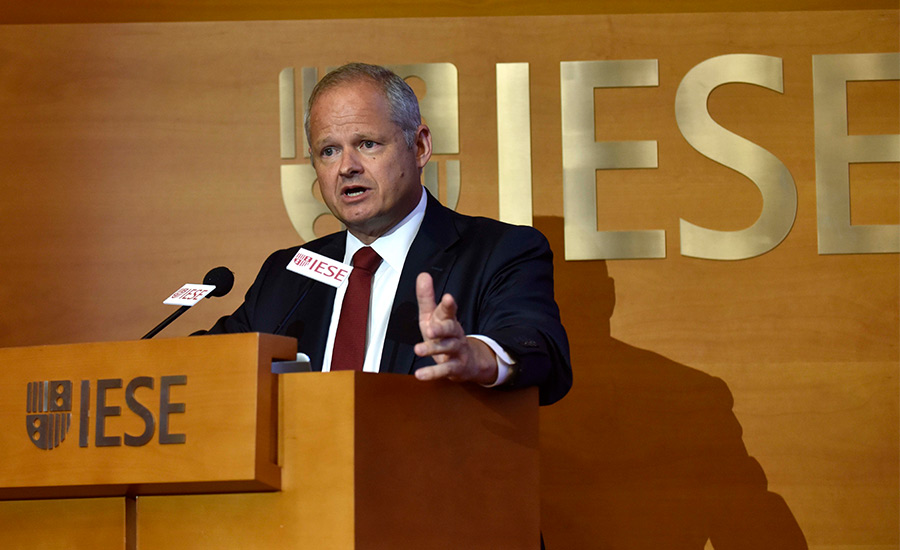
Can self-driving cars respond to motorcycles weaving in and out of traffic? Will China one day dominate global car markets the way it does shoes and mobile phones? Will electric vehicle owners ever overcome their range anxiety? Is it possible to manufacture a car with a 3D printer?
These and other questions were raised during the 32nd IESE AUTO Industry Meeting held on the Barcelona campus this week under the title “The Age of Turbulence”. The meeting featured high-level speakers from global manufacturers such as Renault, Nissan and SEAT; from the many companies that equip and supply the industry such as KUKA Robotics, Siemens and CEVA Logistics; as well as experts from consultancy KPMG and representatives from different Spanish industry associations.
Like most other global industries, the auto sector is watching with concerned eyes the economic and trade policies of the Trump administration in the U.S., along with the Brexit process to unravel the U.K.’s membership in the European Union. But the challenges to the sector go far beyond general trends in geopolitics. Digital technology and Industry 4.0 are rewriting the rules of the factory floor, at the same time the sector adjusts to an equally seismic shift: the move away from fossil fuels to vehicles run on renewable sources of energy.
“I don’t think there will be any easy solutions for the automotive sector in the coming years,” says Marc Sachon, professor of Production, Technology and Operations Management at IESE, and chair of the annual industry meeting.
Race to Produce Electric and Self-Driving Cars
Electric vehicles and self-driving cars are two the hottest areas in the industry, although electric cars still account for a small portion of total sales and autonomous cars are in their infancy.
Globally, pure electric vehicles will represent only 0.5% of new vehicle sales in 2017; in Europe that percentage is a slightly higher 0.8%. But by 2020, electric cars are seen accounting for 4% of new vehicle sales, and five years later that figure is expected to have grown to 9%–15%, said Gilles Normand, senior vice president of Groupe Renault’s Electric Vehicle Program and New Business. While Europe is now at the forefront, developing countries such as India and China, with their enormous market potential, have indicated their commitment to moving toward battery-powered cars.
The Renault-Nissan Alliance has been a pioneer in electric cars, and is the largest producer and seller. Renault now offers four models of electric cars; that number will double by 2022. It expects the price of certain models to be the same as internal combustion cars by 2020, and to trend lower after that.
It’s all positive news for consumers and the environment. “Electric vehicles are a good long-term solution to CO2 emissions and they are a good short-term solution for particulate emissions” especially in densely populated areas, Normand said.
Yet hurdles remain. Those include lowering their cost, ensuring access to raw materials needed for their manufacture, minimizing their environmental impact, and ensuring their batteries can be recycled. And companies and governments are also working to install a growing number of charging stations, so that consumers may drive electric cars without the anxiety of being left without power.
Self-driving cars also face many hurdles, including legal and regulatory issues, from where they will be allowed to drive to how they will be insured. Those issues will become even trickier as they move to so-called Level 5 technology, in which cars are fully automated and humans have no role.
Industry 4.0 Transforming Factories
But while electric and self-driving cars are grabbing headlines, some of the biggest changes in the industry are taking place within factories. Technological changes there take many forms, some that mirror trends in other businesses and some that are unique to the sector, with its costly and specific-use assets.
Changes in technology and Industry 4.0 are likely to completely redesign how factories function, experts said. Production systems will be reconfigurable and intelligent, communicating among themselves and with the workforce.
The same 3D printer, for example, can be used to make a wide range of car parts, and even potentially parts for an airplane or for a car. At the same time, 3D printing offers advantages such as freedom of design, lower costs, greater customization and quicker time to market.
It will be the challenge of the industry to find the best way to incorporate it in their current operations. “This is not a stand-alone technology. It has to integrate into existing manufacturing processes,” said Nikolai Zaepernick, senior vice president for Central Europe at industrial 3D printing company EOS.
Policy and Geopolitics
Another source of uncertainty for the sector is public policy – at global, regional and city levels. Cities are taking an ever-more active role in limiting traffic and encouraging residents to switch from internal combustion cars to greener alternatives – or to avoid cars altogether. As examples, Paris has said it will ban all traditional combustion engine cars from its streets by 2030, while China has said that 20% of new car sales must be new-energy vehicles by 2025.
At a global level, among many other developments, the sector is watching closely ongoing talks on the North American Free Trade Agreement (NAFTA). The U.S. president has said repeatedly that he feels NAFTA punishes American interests, and has indicated that he wants to raise the percentage of American-made parts in cars sold tariff-free within North America.
Any collapse in NAFTA might actually resonate far beyond the U.S., Canada and Mexico to China. While China is the world’s biggest auto manufacturer – making more than the U.S. and Japan combined – it exports a miniscule part of production.
“In reality when we talk about NAFTA we have to talk about China,” said Sachon.
“Any gap created will be filled by China.”